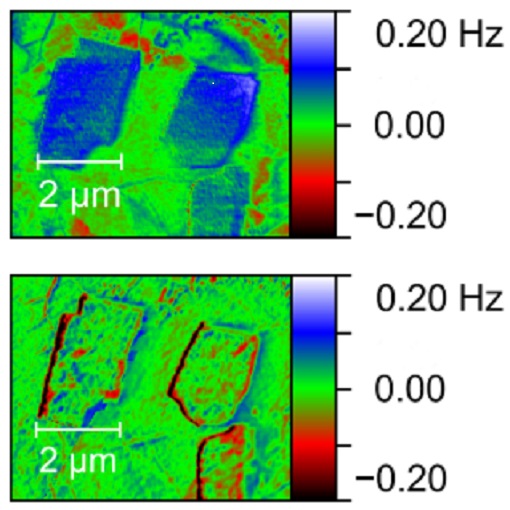
2D magnetic polymers
Exfoliation has become established method for fabrication of van der Waals (vdW) materials. Yet, it is less suitable in case of vdW magnets since many of them are instable at ambient conditions. The group of Eugenio Coronado (University of Valencia, Spain) prepared and studied 2D magnets utilizing pre-synthetic functionalization and subsequent exfoliation of layered magnetic coordination polymers featuring Fe(II) centers and different benzimidazole derivatives. They characterized mechanical and magnetic properties of 2D magnetic polymers. Utilizing an attoMFM microscope in an attoDRY1000 cryostat, they identified magnetic ordering in polymers, as well as the signature of the transition from a canted antiferromagnetic phase to a paramagnetic phase. Their study renders 2D magnetic polymers as promising playground for studying fundamental aspects of 2D magnetism.
This measurement was realized with the attoDRY1000, and the attoAFM I.
Further reading:
J. López-Cabrelles etJ. al., Nature Chemistry 10, 1001 (2018)
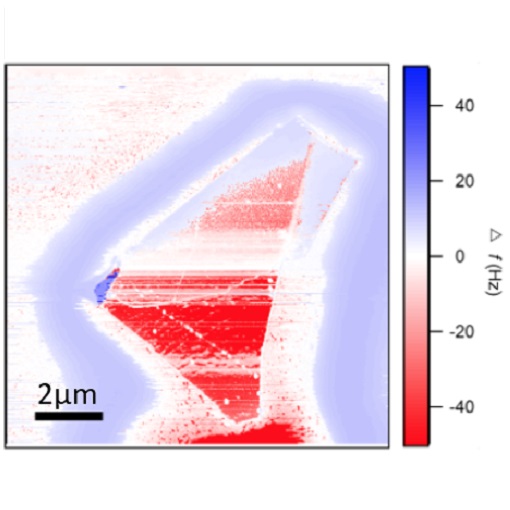
Beyond Ising and Heisenberg
Properties of low-dimensional magnets are strongly influenced by higher-order exchange interactions and quantum effects. The same holds for a van der Waals (vdW) magnet CrI3, which is a quantum material with magnetic properties that cannot be described by Ising or Heisenberg model alone, as demonstrated in a collaboration lead by Eugenio Coronado (University of Valencia, Spain), Kostya Novoselov (National University of Singapore, Singapore & University of Manchester, UK) and Elton Santos (University of Edinburgh, UK). Moreover, the metastability of magnetic domains in CrI3 induces a homogeneous magnetization or even a single domain over the entire surface, which has been imaged by an attoMFM in an attoDRY1000 cryostat. Such domains exhibit hybrid characteristics of both Neel and Bloch type. This study exemplifies how intricate magnetism of vdW magnets can be understood by combining experimental techniques with theoretical calculations, which is a prerequisite of applications of 2D magnets.
This measurement was realized with the attoDRY1000, and the attoAFM I.
Further reading:
D. Abdul Wahab et al., Advanced Materials 33, 2004138 (2021)
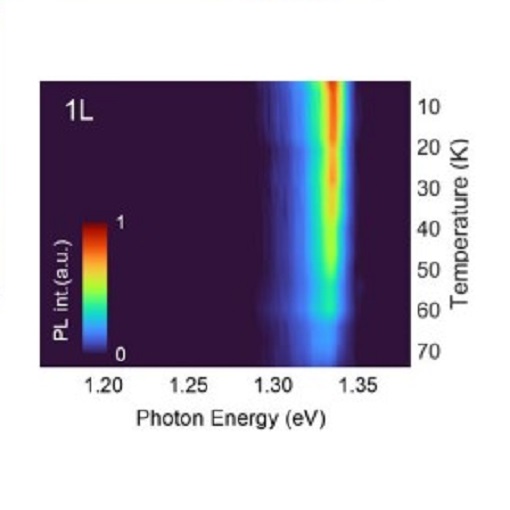
Optically disclosed magnetic ordering
The interest in van der Waals (vdW) magnets is continuously growing. One of suitable playgrounds for exploring the interplay between optical properties and magnetism is the semiconductor metamagnet CrSBr. Researchers led by Eugenio Coronado and Josep Canet-Ferrer (University of Valencia, Spain) conducted photoluminescence measurements and studied the dependence of few-layer CrSBr on temperature, magnetic field and thickness. In particular, they found the connection between the ionization of magnetic donor vacancies and the exciton dynamics around the low temperature magnetic transition. In their study, the group used confocal setup in an attoDRY1000 cryostat as this system allows to apply high magnetic fields at relatively high temperatures. Their findings prove that optical techniques can be very useful in revealing magnetic properties of vdW materials.
This measurement was realized with the attoDRY1000.
Further reading:
F. Marques-Moros et al., ACS Nano 17, 13224 (2023)
Identifying Charged Exciton Complexes in Janus Monolayers
Janus transition-metal dichalcogenide monolayers are artificial materials, where one plane of chalcogen atoms is replaced by chalcogen atoms of a different type. Their built-in out-of-plane electric field gives rise to long-lived dipolar excitons, while preserving direct-bandgap optical transitions in a uniform potential landscape. In this paper, the group of Mete Atatüre (University of Cambridge, UK) in collaboration with Sefaattin Tongay's group (Arizona State University, USA) identified the neutral and the negatively charged inter- and intravalley exciton transitions in Janus WSeS monolayers with ~6 meV optical line widths. By conducting magneto-optic measurements with a closed-cycle cryostat attoDRY1000 with an 8T magnet and high NA objective LT-APO, they further indicate that monolayer WSeS has a direct bandgap at the K points. Their results pave the way for the development of Janus-based optoelectronic devices.
This measurement was realized with the attoDRY1000.
Further reading:
S.G. Matthew et al., ACS Nano 17, (2023)
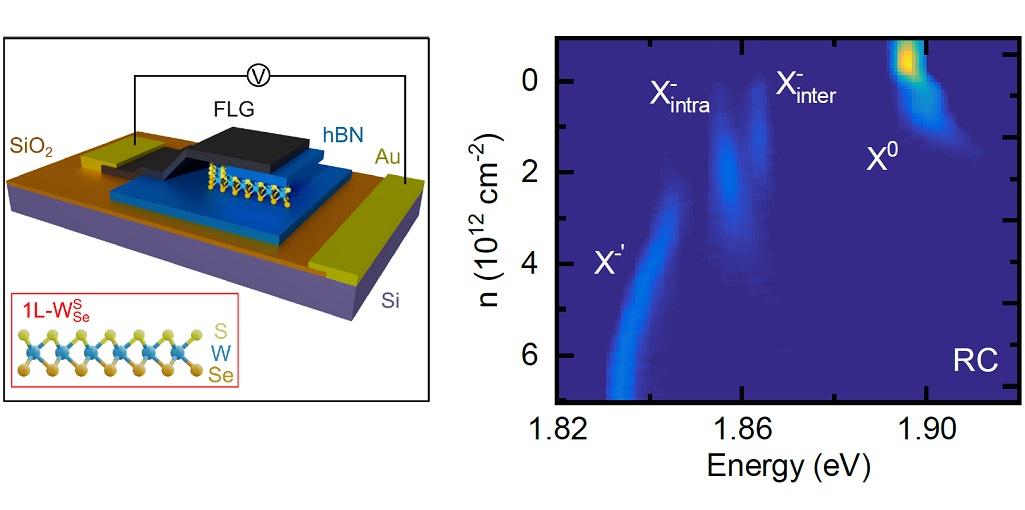
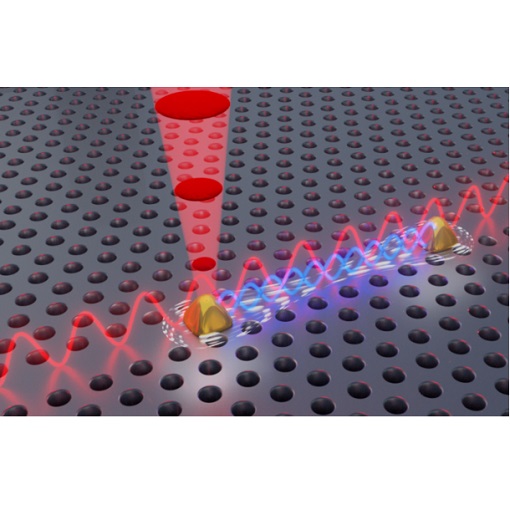
Interacting single-photon emitters
Quantum photonics research focuses on miniaturized devices that transmit quantum states of light. The quantum states which are the most sought after are entangled states, because they are necessary for realization of quantum communication and quantum computing. The team lead by Peter Lodahl (Niels Bohr Institute, University of Copenhagen, Denmark) has achieved a major breakthrough – interaction between two single-photon emitters (SPEs). They have achieved interaction by embedding SPEs in a photonic crystal waveguide, that extended the range of the dipole-dipole coupling, which would otherwise be very short-ranged, i.e. substantially smaller than the corresponding wavelength. They have measured collective response of two interacting emitters and demonstrated ability to control them simultaneously. In this study they have been using an attoCFM I confocal microscope in an attoDRY1000 cryostat, where they placed their quantum photonics chip. Their achievement represents reaching a long-awaited milestone on the quantum roadmap, and is essential for scaling up of quantum computing and quantum communication technology.
This measurement was realized with the attoDRY1000, and the attoCFM I.
Further reading:
A. Tiranov et al., Science 379, 389 (2023)
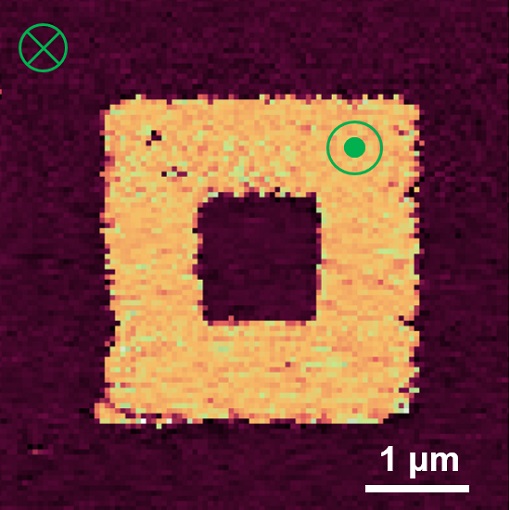
Emergent magnetoelectric phase transition
Complex oxides with a broken symmetry can exhibit various, often emergent, phases. This is in particular facilitated by designing superlattices of complex oxides. The group of Jinxing Zhang (Beijing Normal University, China) has constructed a superlattice by alternately stacking a Ruddlesden–Popper and a perovskite oxide, which resulted in artificially designed ferroelectricity and emergent magnetoelectric (ME) phase transition. The existence of ferroelectric domains below 90 K has been verified by PFM, by using an attoAFM I microscope with a PFM upgrade in an attoDRY1000 cryostat. The accompanying existence of Dzyaloshinskii–Moriya interaction (DMI) and net magnetization have been verified by Brillouin light scattering. Furthermore, external magnetic field suppresses electrical polarization, which confirms the existence of a direct ME effect. This study shows that engineering of interfacial DMI is a promising tool for generating exotic phases and orders in systems with correlated electrons.
This measurement was realized with the attoDRY1000, and the attoAFM I.
Further reading:
X. Liu et al., Nature Commun. 12, 5453 (2021)
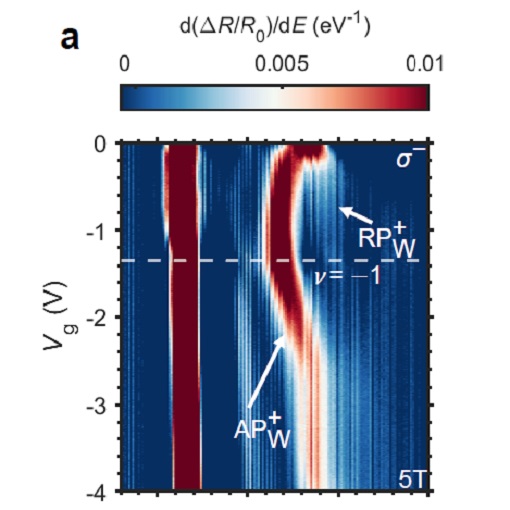
Exciton-polarons optical fingerprint in moiré superlattice
Two-dimensional moiré materials provide a highly tuneable platform to investigate strongly correlated electronic states. Such emergent many-body phenomena can be optically probed in moiré systems created by stacking two layers of transition metal dichalcogenide semiconductors: optically injected excitons can interact with itinerant carriers occupying narrow moiré bands to form exciton-polarons sensitive to strong correlations. Here, the group of Brian Gerardot (Heriot-Watt University, UK) investigates the behaviour of excitons dressed by a Fermi sea localised by the moiré superlattice. Using temperature dependent magneto-optical spectroscopy with attoDRY1000, they identify the nature of exciton-polarons in the presence of strongly correlated electronic states and reveal the rich potential of theu MoSe2/WSe2 platform for investigations of Fermi–Hubbard and Bose–Hubbard physics.
This measurement was realized with the attoDRY1000.
Further reading:
Campbell, A.J. et al., npj 2D Mater Appl 6, 79 (2022)
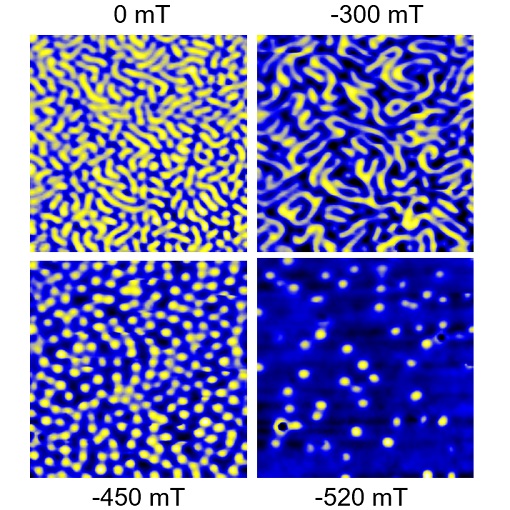
Skyrmions induced by strain gradient
Dzyaloshinskii-Moriya interaction (DMI) arises from breaking the inversion symmetry in noncentrosymmetric crystals, or emerges at thin-film interfaces. DMI and its relation to magnetic anisotropy are decisive in creating conditions for creation of chiral spin structures. The group of Prof. Jinxing Zhang (Beijing Normal University, China) has shown how DMI can be generated in a centrosymmetric material La0.67Sr0.33MnO3 by a strain gradient. Such DMI induces topological spin textures (skyrmions and spin spirals) accompanied by topological Hall effect in the range from 20 - 300 K. They imaged skyrmions and spin spirals by magnetic force microscopy (MFM) utilizing an attoAFM I microscope with attoMFM upgrade in an attoDRY1000 cryostat. Their findings open the path to exploring the potential for centrosymmetric magnetic materials in spintronics applications.
This measurement was realized with the attoDRY1000, and the attoAFM I.
Further reading:
Y. Zhang et al., PRL 127, 117204 (2021)
Harnessing the emergent potential of CrI3 flakes
For materials scientists it is not only essential to understand the properties of materials, but also to be subsequently able to design materials with desired properties that will in turn be implemented in devices. Van der Waals materials (vdWMs) have proven to be particularly rewarding when it comes to designing desired properties. Yet, among vdWMs there is a scarcity of magnetic materials, which would potentially be technologically useful for e.g. data storage or sensorics. CrI3 is one of the rare vdWMs that exhibits intrinsic magnetism. Even though this occurs only at low temperatures and the material is air-sensitive, CrI3 has become a notable playground for investigating and developing useful properties in vdWMs in recent years.
The group of Jie Shan and Kin Fai Mak (Cornell University, USA) have extensively studied magnetic ordering in CrI3 flakes, in a very application-oriented fashion. They have shown that interlayer antiferromagnetic coupling in CrI3 can be tuned up by almost 100% with pressure, before the transition to ferromagnetism occurs [1].
Moreover, in bilayer CrI3 they have demonstrated tunability of antiferromagnetic resonances in the range of tens of GHz by means of electrostatic gating, which indicates potential for ultrafast data storage and processing [2].
Furthermore, the basis has been laid for potential applications in magnetic actuation and sensing. The group has demonstrated magnetostriction in bilayer antiferromagnetic CrI3: in mechanical resonators made from CrI3 flakes, the resonant frequency depends on the magnetic state of the material [3].
Utilizing the property of controlling the interlayer magnetic order in CrI3 by electric field, the group has designed and tested a spin transistor based on CrI3 flakes. As magnetization configurations in this device are not controlled by spin current, but rather by gate voltage, the spin transistor can achieve a conductance ratio of ~400%, which is suitable for non-volatile memory applications [4].
Their results have been obtained with help of attoDRY1000 & attoDRY2100 cryostats, which have been used in conjunction with various experimental techniques like Raman spectroscopy, magnetic circular dichroism, magneto-optical Kerr effect, and tunnel magnetoresistance measurements.
This measurement was realized with the attoDRY1000, and the attoDRY2100.
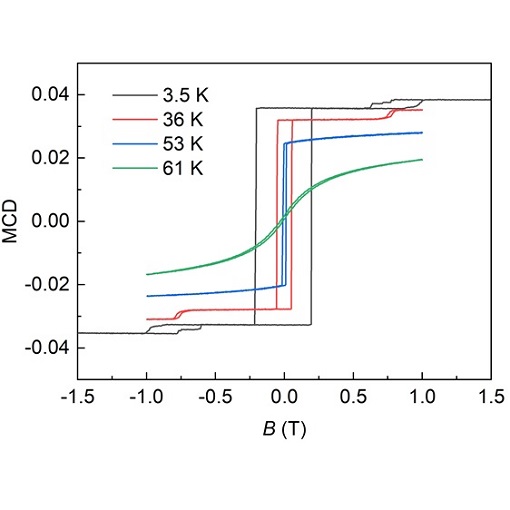
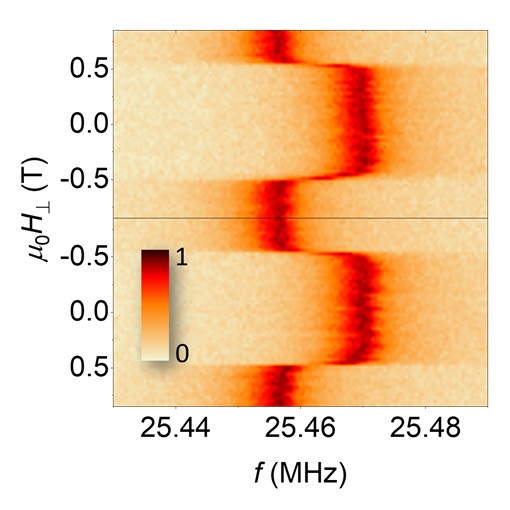
Revealing physical origin of electronic phase separation in complex oxides
Manganites exhibit various nonlinear responses to external stimuli, which makes them potentially useful materials for electronic devices. While nonlinear responses in complex oxides have been correlated to large-scale electronic phase separation (EPS), the physical origin of EPS has for a long time remained puzzling. The group of Jian Shen (Fudan University, China) has provided the first experimental evidence that the disorder induced by chemical doping is a prerequisite for EPS, thus verifying the theoretical predicition.
This result has been directly obtained by comparative MFM measuerments on chemically ordered manganite film vs. the chemically disordered one, utilizing an attoAFM I with attoMFM upgrade in an attoDRY1000 cryostat. Their finding opens the path to focused design of complex oxides with desired properties for applications, especially those exhibiting colossal magnetoresistance.
This measurement was realized with the attoDRY1000, and the attoAFM I.
Further reading:
T. Miao et al., PNAS 117, 7090 (2020)
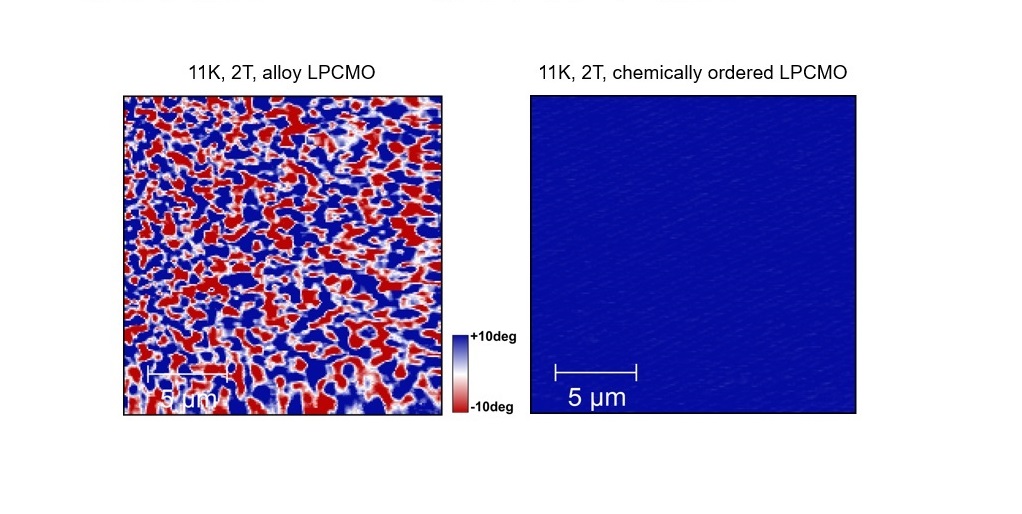
Anisotropic formation of exciton magnetic polarons in colloidal quantum dot
Colloidal nanocrystal quantum dots are - due to their reproducible and scalable fabrication process - promising candidates for many industrial applications like solar cells, LEDs and displays. Doping semiconducting colloidal nanocrystals with magnetic ions can lead to extraordinary effects, such as light-induced magnetization - aka exciton magnetic polaron (EMP). The group of Gerd Bacher (University of Duisburg-Essen, Germany) carried out temperature- and magnetic-field-dependent photoluminescence measurements on single colloidal Mn2+:CdSe/CdS quantum dots, thus shedding light on the fundamental processes that lead to EMP formation. The measurements were realized with attoCFM I in attoDRY1000 with 3D magnetic field. These findings open a new path for controlling the orientation of light-induced magnetism.
This measurement was realized with the attoDRY1000, and the attoCFM I.
Further reading:
S. Lorenz et al., Nano Lett. 20, 1896 (2020)
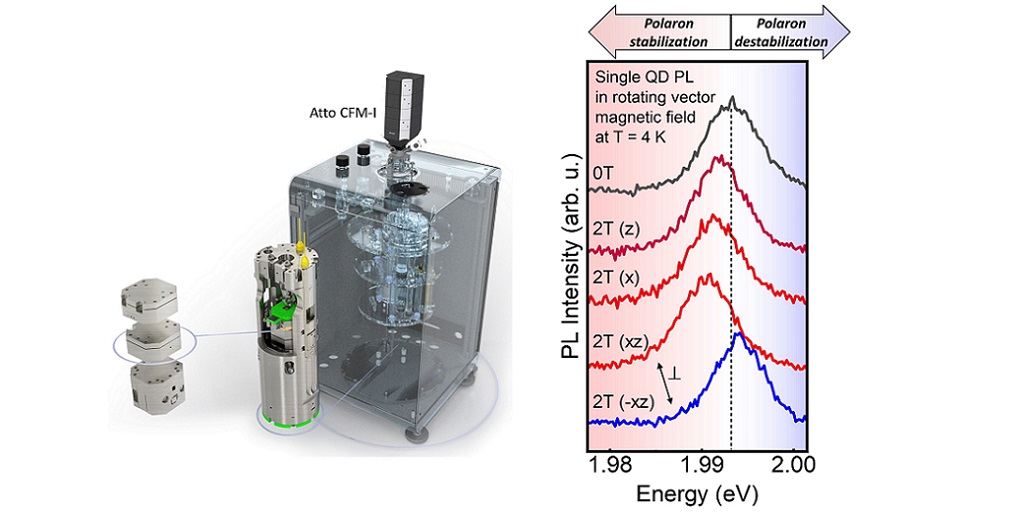
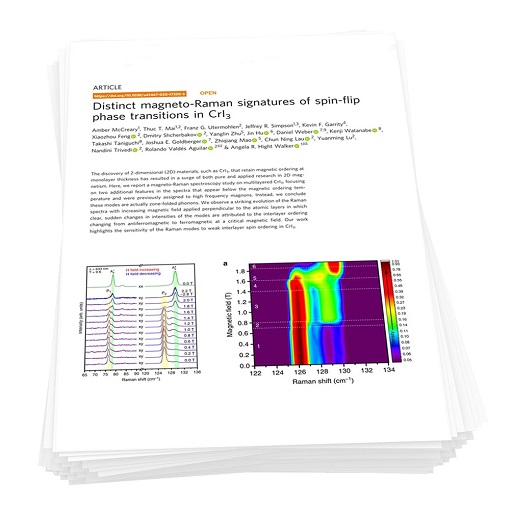
Spin-Flip Phase Transitions in Multi-Layered CrI3
Newly discovered magnetic 2D materials, such as CrI3, are among the most interesting materials in nowadays research. While ferromagnetic in bulk, thin multilayers of CrI3 can be switched between ferro- and antiferromagnetic layer stacking with electric & magnetic fields, or by applied pressure. Using an unique magneto-Raman measurement capability based on attoDRY1000 and LT-APO objective, the group of Angela Hight Walker (NIST, USA) identified the transition between the antiferromagnetic and ferromagnetic phases as a function of magnetic field and temperature by tracking the lattice vibrations (phonon modes) of CrI3. Their findings highlight the sensitivity of Raman modes to magnetic order and spin flips of single layers. The study establishes magneto-Raman spectroscopy as a valuable tool to investigate magnetic phase transitions in 2D van der Waals magnets.
This measurement was realized with the attoDRY1000.
Further reading:
A. McCreary et al., Nature Commun. 11, 3879 (2020)
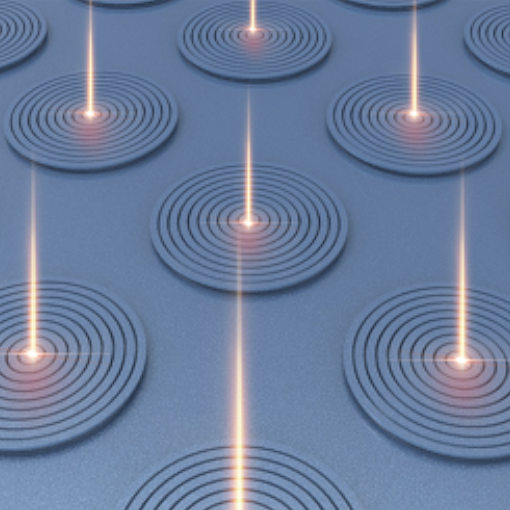
Single photon sources on the way to QIP
Single-photon sources will be a fundamental building block for future quantum information devices. For advanced implementations, the photon sources must emit simultaneously high efficiency and indistinguishability photons. On the way towards an optimal solid-state based single-photon source, the group of Chaoyang Lu and Jian-Wei Pan at the University of Science and Technology of China (Shanghai, CN) presented a background-free method (two-color excitation) for generating spectrally isolated indistinguishable photons [1] and polarized single photons from elliptical micro-pillars. The optical measurements were performed using an attoCFM I cooled by a closed cycle attoDRY2100 cryostat. With their measurement method they demonstrated a state-of-the-art polarized single-photon efficiency of up to 60% and an indistinguishability of up to 0.975 for the micro pillar device [2], which allowed them to perform the first 20 photon experiment leading toward quantum supremacy [3].
This measurement was realized with the attoDRY1000, and the attoCFM I.
Single-photon Source at Telecom Wavelength for Quantum Computation
One of the most promising approaches towards devices that could act as a building block for quantum computing and quantum information technology are quantum dot based single photon sources. Some of the standing technical challenges are coupling efficiencies, lossy transmission of quantum states, and the integration of other photonic devices such as electro-optic modulators.
The group of Edo Waks at the University of Maryland (Maryland, USA) tackled these demands by developing an alignment-free fiber-coupled single photon source emitting at the telecom wavelength.
The heart of the device is a nanobeam with an embedded quantum dot attached to a tapered fiber. The photons emitted from the quantum dot are guided to the fiber, from which it can be transferred to other optical device. The characterization required a home-made all-fiber photoluminescence setup that was cooled to 4 K using the closed cycle attoDRY1000 cryostat. The observed single-photon emission was detected with a brightness of 1.5 % and a purity of 86 %. With these results the developed device is a promising candidate for quantum computing as it offers the required usability and performance.
This measurement was realized with the attoDRY1000.
Further reading:
Chang-Min Lee et al.; Appl. Phys. Lett. 114, 171101 (2019)

Fine-scale Stripey Morphology of an Iron Pnictide - New Findings in Material Science
Iron-based superconducting pnictides feature relatively high transition temperature and a co-existence of the superconducting state with antiferromagnetic ordering. This remarkable combination brings these materials into the focus of research. The group of Prof. Susannah Speller at the Materials Department of the University of Oxford (Oxford, UK) used an attoAFM I cooled by a closed cycle attoDRY1000 for magnetic force measurements at about 4.6 K to investigate the local electronic structure and chemistry of RbxFe2-ySe2 crystals.
The group showed a fine-scale stripey morphology of the superconducting phase which - combined with previous findings - paves the way to understand the intriguing electronic and magnetic properties of these compounds.
This measurement was realized with the attoDRY1000, and the attoAFM I.
Further reading:
P Dudin et al.; Supercond. Sci. Technol. 32, 044005 (2019)
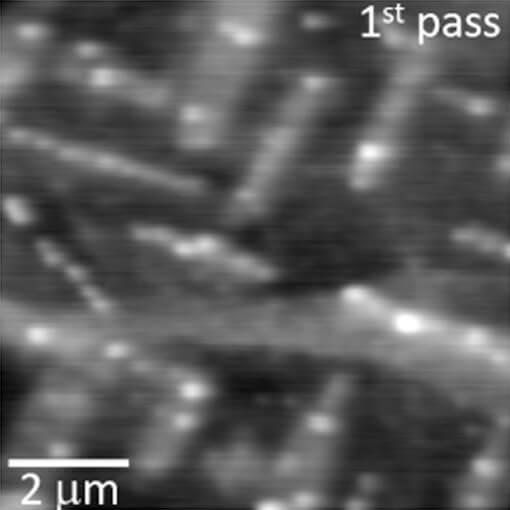
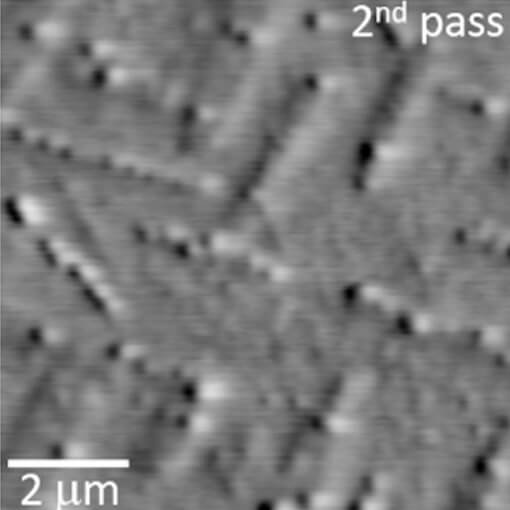
A new way to modulate exciton-complex emissions of TMDs
A new type of atomically layered transition-metal dichalcogenides (TMD) was developed by Mr. Taishen Li and co-workers from the University of Science and Technology of China (Hefei, China): a triangular inkslab-like WSe2 homojunction with a monolayer in the inner surrounded by a multilayer frame.Optical and scanning photocurrent microscopy (SPCM) measurements performed with the attoCFM I, cooled by a closed cycle attoDRY1000 to cryogenic temperatures, shows a clear redshift of the photoluminescence peaks from the center to the edge region of the inner monolayer, reflecting a high charge density gradient. In addition, a significant rectifying behavior and photovoltaic response across the homojunction is observed. All in all, the results lead to efficient modulation of the exciton-complex emissions of TMDs.
This measurement was realized with the attoDRY1000, and the attoCFM I.
Further reading:
T. Li, et al., ACS Nano 12 (5), pp 4959–4967 (2018)
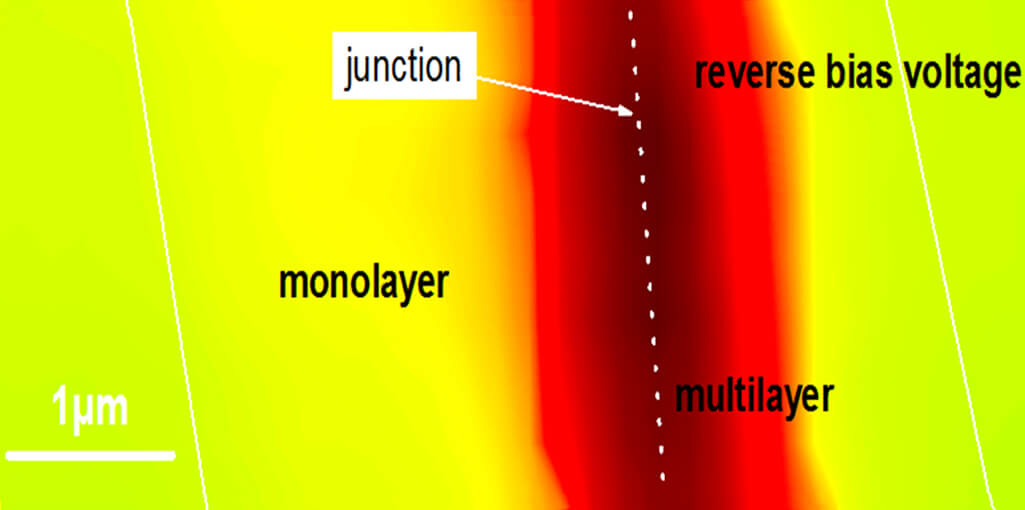
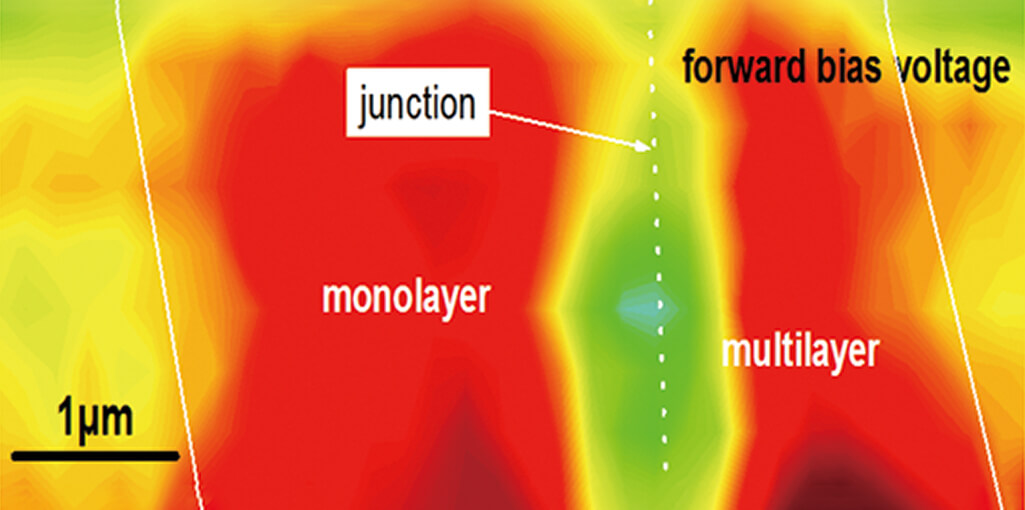
Measurements of field-driven transformation of a domain pattern
The group of Erik Folven at the Norwegian University of Science and Technology (Trondheim, Norway) used an attoAFM I for MFM measurements with a closed cycle attoDRY1000 to demonstrate how topological defects may be invoked to understand magnetic domain state transitions. The atomically sharp and magnetized tip of the microscope is scanned across the thin film surface to pick up the out-of plane stray fields from the sample and thus is sensitive primarily to spin textures such as domain walls and defects. The MFM measurements taken at 5K help to understand and describe micromagnetic domain state transitions and to assess their stability in remanence. This insight may open for new approaches to control the switching properties of micro- and nanomagnets.
This measurement was realized with the attoDRY1000, and the attoAFM I.
Further reading:
S. D. Sloetjes, et al., Appl. Phys. Lett. 112, 042401 (2018)

Coupling single defects to a nanowire
Using an attoCFM I cooled by an attoDRY1000, the group of Edo Waks at the University of Maryland (Maryland, USA) succeeded to couple quantum emitters in a tungsten diselenide (WSe²) monolayer self-aligned to the surface plasmon mode of a silver nanowire. The achieved lower bound coupling efficiency was measured to be 26% ± 11% in average from the emitter into the plasmonic mode of the silver nanowire. The presented technique is versatile to construct coupled systems consisting of diverse plasmonic structures and single-defect emitters in a range of two-dimensional semiconductors. Such a coupled system could be used for applications such as ultra-fast single-photon sources, which paves a way toward super-compact plasmonic circuits.
This measurement was realized with the attoDRY1000, and the attoCFM I.
Further reading:
T. Cai, et al., Nano Lett. 17, 6564 (2017)
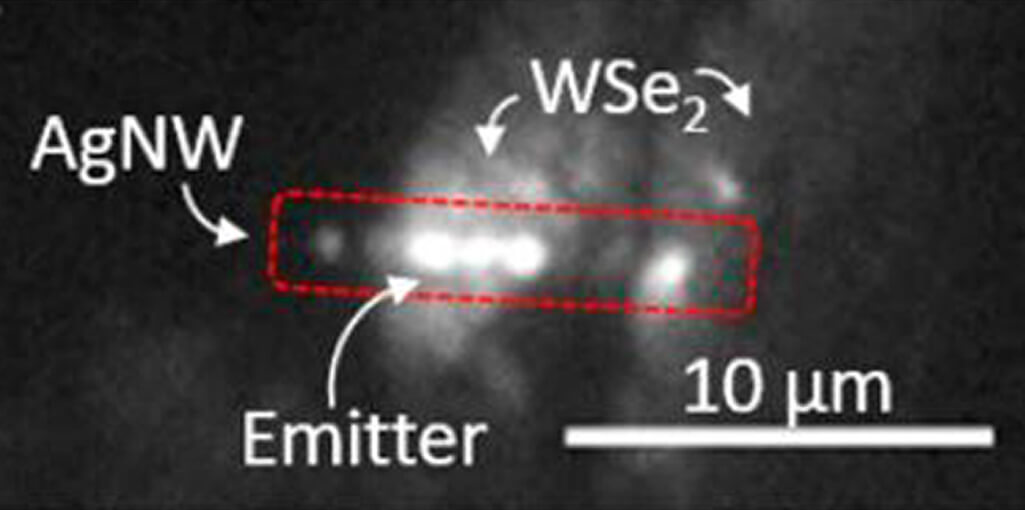
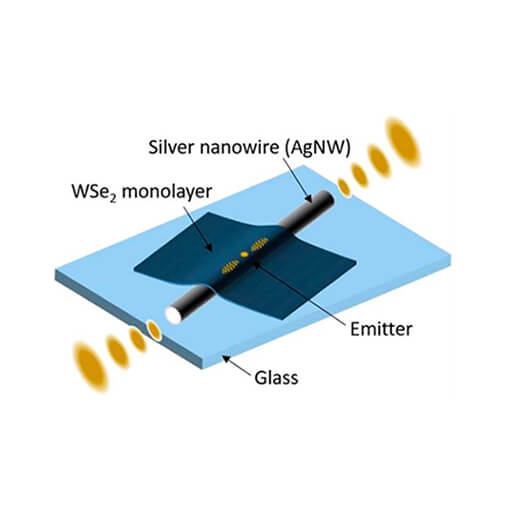
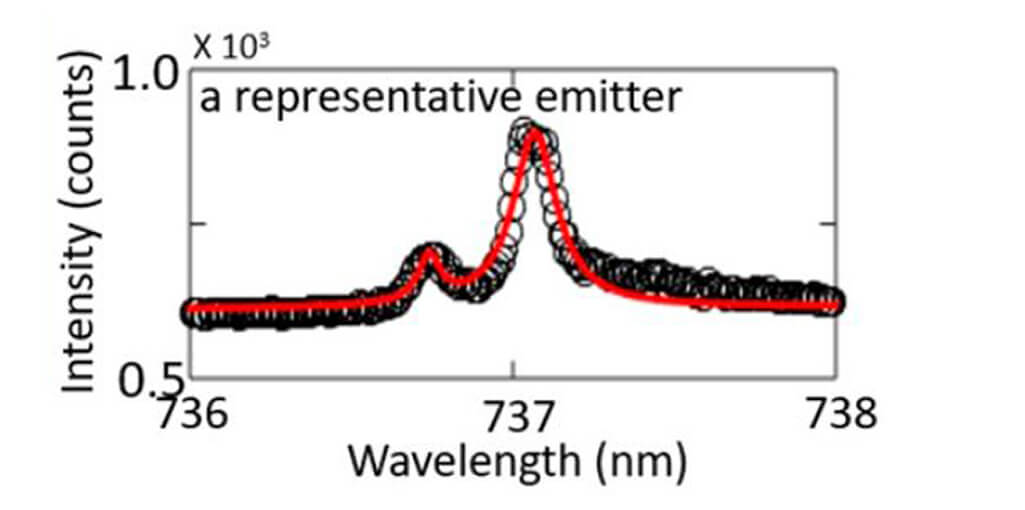
Quasi-2D Magnon identified via Magneto-Raman Spectroscopy
Due to myriad of interesting electronic, mechanical and optical properties, van der Waals materials have been extensively studied in recent years. Exploring their magnetism has been neglected, mainly because of scarcity of long-range magnetic order in 2D materials. Yet, when it exists, like in FePS³, it poses a huge technological potential, particularly since magnetic properties of 2D materials are easily tuneable. The group of Angela Hight Walker at NIST (Gaithersburg, Maryland, USA) developed and used a state-of-the-art cryogenic Raman system cooled by an attoDRY1000 to investigate FePS³ in an antiferromagnetic ordering which leads to a folding of the Brillourin zone and thus to a new modes appearing below the Néel temperature TN. With their temperature and magnetic-field dependent Raman spectra, the group established that one of the appearing modes can only be explained as a magnon and not with a phonon, contrary to previous assumptions. The magnon frequency was detected at 3.7 THz which is an order of magnitude faster than in the previously studied MnPS3. To the best knowledge, this is the first verification of a quasi-2D magnon in a layered material by magneto-Raman spectroscopy.
This measurement was realized with the attoDRY1000, and the attoCFM I.
Further reading:
A. McCreary et al., Phys. Rev. B 101, 064416 (2020)Press release
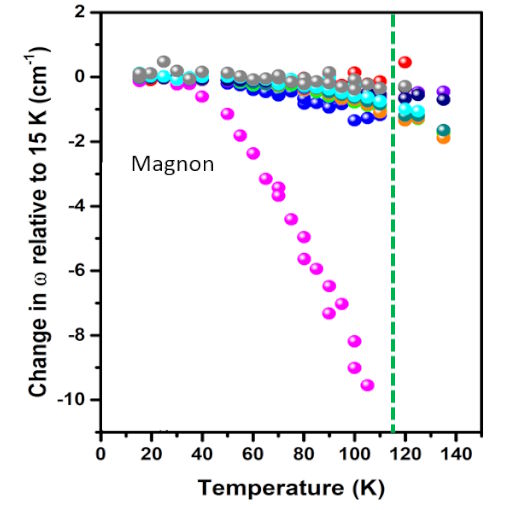
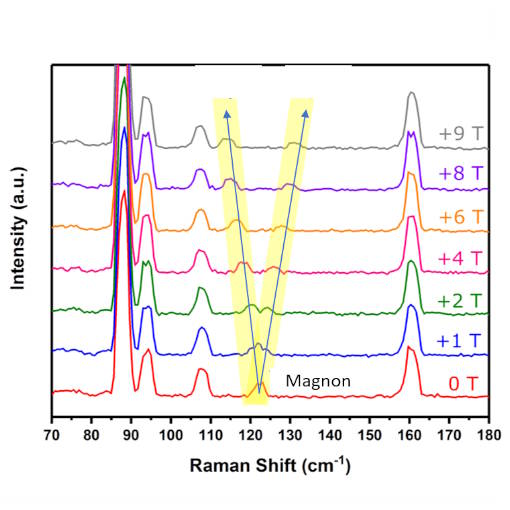
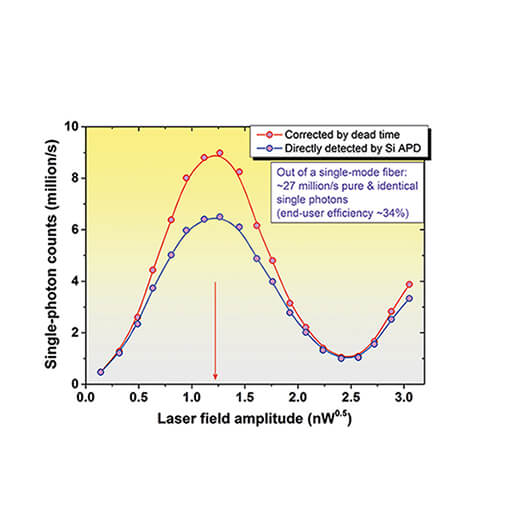
Scalable Architecture for Multi-Photon Boson Sampling
Research groups led by Jian-Wei Pan & Chao-Yang Lu in China and Sven Höfling in Germany & UK have successfully demonstrated the first quantum simulator based on single photons that beats early classical computers. In Nature Photonics, they report on “High-efficiency multiphoton boson sampling“, implementing 3-, 4-, and 5-boson-sampling with rates which are more than 24,000 times faster than all previous experiments, and 10-100 times faster than the first electronic computer (ENIAC) and transistorized computer (TRADIC) in human history. Their work, which was carefully prepared and accompanied by their 3 previous papers published in PRL (see below), kick starts a new era of photonic quantum technologies-going beyond proof-of-principle demonstrations and building a quantum machine to actually race against different generations of classical computers. In recognition of their achievements in quantum teleportation research, the very active and highly respected Chinese group recently also won the 2015 Physics World Breakthrough of the Year award and the 2015 State Nature Science First Class Award in China. In addition, Chao-Yang Lu was portrayed by Nature last summer as one of the “Science stars of China”. For their quantum dot experiments, his group uses three attoDRY cryostats equipped with attocube positioners, scanners and cryogenic objectives. Visit the group’s homepage for more information on their experiment.
This measurement was realized with the attoDRY1000, and the attoCFM I.
Cryogen-free confocal measurements on a single quantum dot
The data to the left show photon anti-bunching experiments performed on a single quantum dot. The optical insert was cooled down by a closed cycle attoDRY1000 cryostat. Without any special effort the customer observed that the dot luminescence intensity remains constant within 14% over 10 hours.
(The data was generously provided by Benito Alén Millán, Molecular Beam Epitaxy group at the Instituto de Microelectrónica de Madrid, Spain)
This measurement was realized with the attoDRY1000.
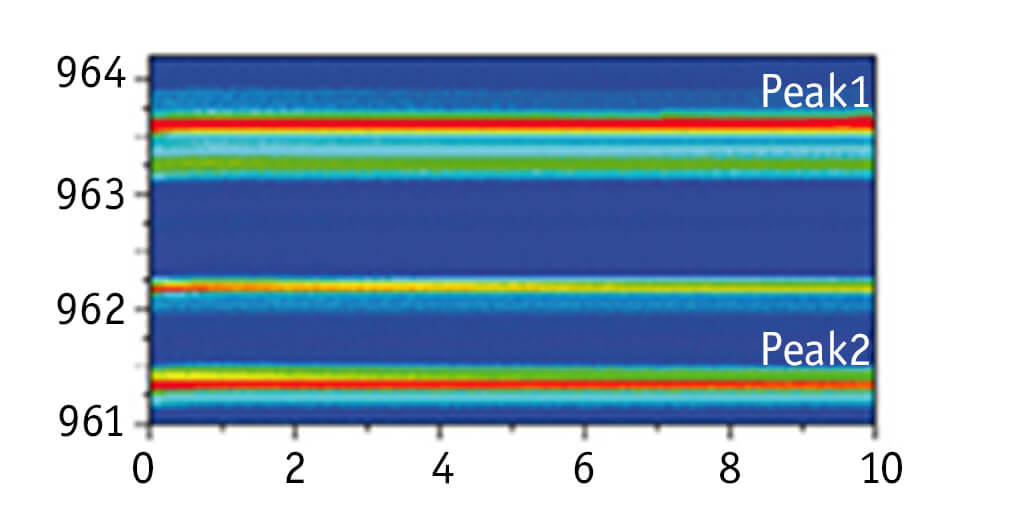
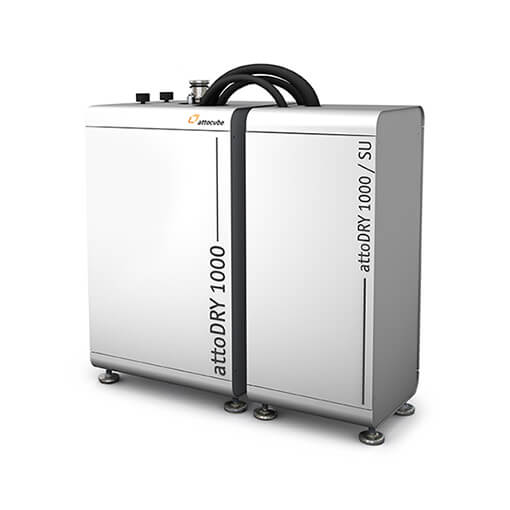
Scanning probe microscopy in an ultra-low vibration closed-cycle cryostat
The attoDRY1000 is a cryogen-free cooling system setting new performance benchmarks. The attoDRY1000 was specifically designed to provide an ultra-low vibration measurement platform for cryogenic scanning probe experiments without the need for liquid helium.
The standard closed-cycle system enables vibration-sensitive experiments in a temperature range from 4 K to 300 K. The optionally available microscope inserts are cooled by a controlled exchange gas atmosphere. Superconducting magnets up to 9 T are available as an option. Due to a proprietary design, mechanical vibrations created by the pulse-tube coldhead are decoupled from the measurement platform.
When measured with the attoAFM I, vibration amplitudes of less than 0.15 nm RMS are routinely achieved (bandwidth of 200 Hz, vertical direction). Despite the mechanical decoupling between coldhead and sample platform, the cooling performance ot the attoDRY1000 is simply outstanding. Temperatures as low as 3 K and probe cooldown times as fast as 1 hour make cryogenic scanning probe experiments a delight.
For the attoDRY1000, a wide variety of scanning probe microscopy inserts is available, ranging from confocal (CFM) to magnetic force microscopy (MFM).
This measurement was realized with the attoDRY1000, and the attoAFM I.
Further reading:
F.P. Quacquarelli et al., arXiv:1404.2046v1
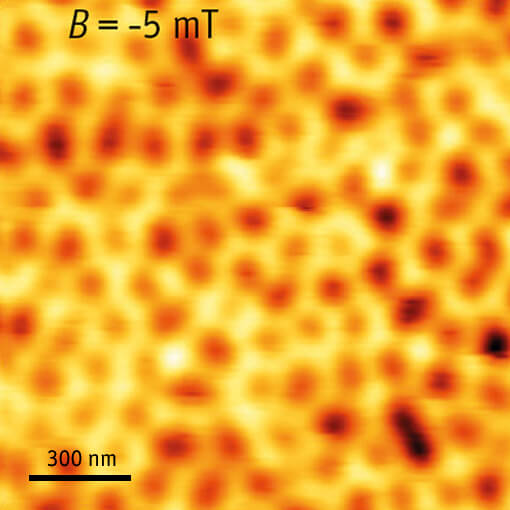
MFM imaging of a Skyrmion lattice
In collaboration with Jan Seidel from UNSW Sydney, A. Bauer & C. Pfleiderer, TU Munich we have successfully imaged the elusive Skyrmions and their magnetic field evolution in the attoDRY1000 cryostats using the attoAFM/MFM I. See what’s possible nowadays with our sophisticated commercial instruments!
This measurement was realized with the attoDRY1000, and the attoAFM I.

